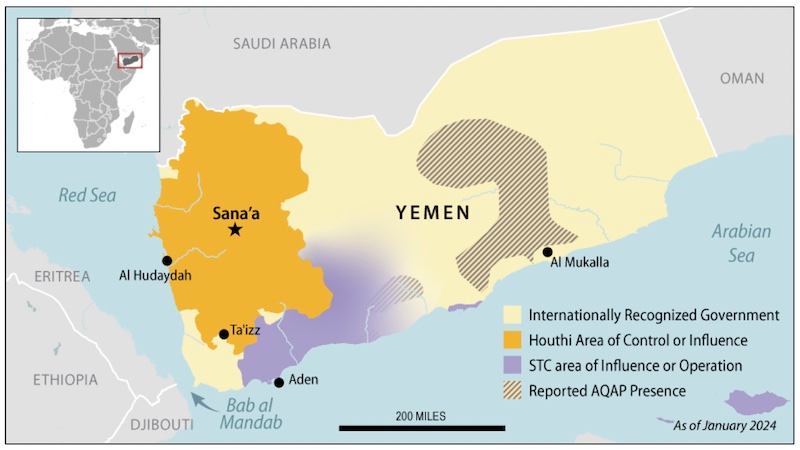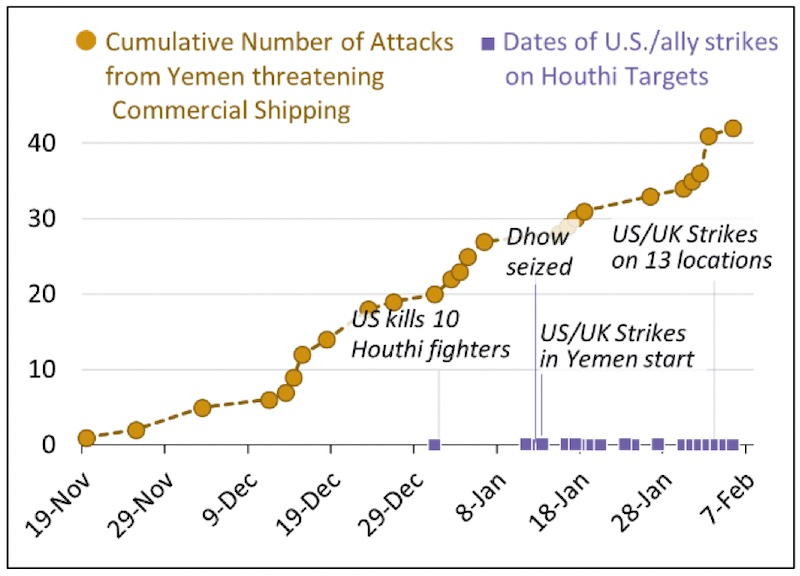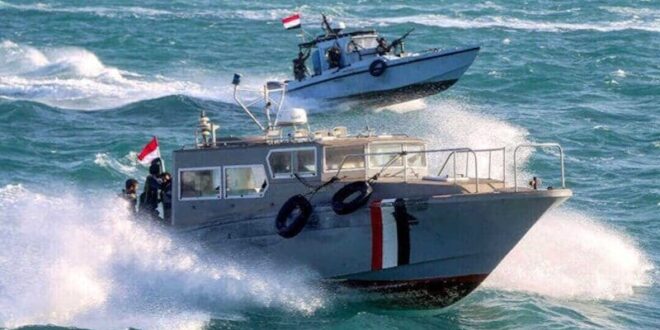Yemen is a conflict-afflicted nation along the strategic Bab al Mandab Strait, one of the world’s most active shipping lanes. Since 2015, a civil war has pitted the Iran-backed Houthi movement against Yemen’s internationally recognized government, its backers, and other anti-Houthi forces.
Foreign intervention complicates the conflict, which has contributed to what United Nations agencies have described as “one of the largest humanitarian crises in the world.” An uneasy truce has frozen conflict lines since 2022 (Figure 1). Houthi attacks on international shipping have drawn major international attention back to Yemen since October 2023, and have prompted U.S.-led coalition counterstrikes. In December 2023, President Joe Biden notified Congress that “a small number” of U.S. forces pursue counterterrorism missions in Yemen.
Overview and Key Stakeholders
Long-running Yemeni disputes over governance and energy resources have deepened since 2015 amid foreign influence and intervention. The Republic of Yemen was formed by a 1990 merger of the Sana’a-led Yemen Arab Republic (a former Ottoman province, then Zaydi Shia-ruled kingdom) and the Aden-led People’s Democratic Republic of Yemen (a former British colony and protectorate, then independent Marxist regime). North-south tensions and conflict have recurred since the 1960s, and a southern independence movement remains active. Tribal networks and local actors are the most influential parties in many areas of the country.
Arab Spring-era protests and unrest led the president of the Republic of Yemen Government (ROYG) in 2012 to resign. A U.N.-mediated transition and national dialogue sought to broker new governing arrangements. The Houthi movement (alt. Ansar Allah or Partisans of God), a north Yemen-based Zaydi Shia network, opposed U.N.-backed outcomes and resumed the insurgent posture they had taken in previous rounds of fighting with the ROYG.
In 2014, the Houthis seized the capital, Sana’a, and later advanced on Aden. ROYG leaders fled and requested international intervention. In March 2015, a coalition led by Saudi Arabia began a military campaign against the Houthis, whose attacks across Yemen’s borders grew in complexity and scope with deepening support over time from Iran. The United States has provided logistical, intelligence, and advisory support to the coalition, but ended aerial refueling and limited arms sales to Saudi Arabia in response to civilian casualties and congressional action.
In 2019, tensions among anti-Houthi forces in the ROYG (backed by Saudi Arabia) and the separatist Southern Transitional Council (STC, backed by the United Arab Emirates) led to open warfare. A 2020 power-sharing agreement formed a coalition government. Since 2022, an eight-person Presidential Leadership Council (PLC) has led Yemen’s internationally recognized government. That year, the ROYG and Houthis signed a truce, halting military operations and establishing humanitarian measures. Lines of conflict, in some areas mirroring Yemen’s pre- unification borders, remain frozen (Figure 1). Meanwhile, Al Qaeda in the Arabian Peninsula (AQAP) and the Islamic State have remained active in remote areas.

Conflict Status and U.S. Diplomacy
Since 2015, conflict has caused widespread humanitarian suffering and significant infrastructure damage in Yemen, long the Arab world’s poorest country. In late 2021, the UN estimated that 377,000 people had died as a result of the conflict (including combatants) and that nearly 60% of deaths were from non-military causes, such as lack of food, water, or health care. Foreign observers have denounced human rights violations attributed to all parties to the conflict.
Since the Houthi-ROYG truce expired in October 2022, fighting has not returned to “pre-truce levels,” but some exchanges of fire and clashes have occurred. Houthi cross- border attacks into Saudi Arabia and coalition airstrikes, once prominent elements of the war, largely ceased. U.S. diplomats, led by Special Envoy for Yemen Ambassador Timothy Lenderking, say they seek to transform the truce into a durable ceasefire, enable a political solution, and support U.N. Special Representative for Yemen Hans Grundberg.
Since the October 2023 Hamas-led attacks on Israel and onset of the war in Gaza, Houthi strikes on Israel and on commercial shipping vessels and U.S. and allied naval vessels in the Red Sea and Gulf of Aden have prompted broader congressional attention to Yemen and its future. Risks of renewed conflict in Yemen and widening U.S.- Houthi clashes are evident. In addition to the diplomatic objectives described above, U.S. policy goals in Yemen include restoring security to shipping lanes, interdicting Iranian aid to the Houthis, combatting transnational terrorist groups, and ensuring humanitarian aid delivery.
Maritime Attacks and U.S. Responses
Following the October 7, 2023, Hamas attacks on Israel and Israel’s military response in Gaza, the Houthis began targeting Israeli territory as well as commercial vessels transiting the Bab al Mandab Strait (see Figure 2). Initially, the U.S. Navy intercepted Houthi-launched projectiles and prevented attempted Houthi seizures of vessels.
On December 18, the U.S. launched Operation Prosperity Guardian, a coalition formed to patrol the Red Sea. Despite international action, continuing attacks have diverted traffic from the Red Sea and driven up shipping firms’ costs, insurance premiums, and ocean freight rates.

Source: CRS, using data from U.S. Department of Defense and media reports. Attack and response data subject to change.
Since December 31, exchanges of fire between Houthi forces and U.S. forces and U.S. allies have resulted in deaths of Houthi fighters, damage to merchant vessels, and threats to U.S. and allied service personnel. Two U.S. personnel died in a January operation that intercepted a shipment of Iranian missile components to the Houthis.
On January 11, 2024, following the passage of UN Security Council Resolution 2722, U.S. and allied forces conducted dozens of joint strikes on Houthi targets across Yemen. U.S. and allied strikes on Houthi military targets have continued, as have Houthi attacks on U.S. and allied vessels and commercial ships. Some reports indicate that Iran has been sending additional military advisors and more sophisticated weapons to support Houthi actions.
Humanitarian Situation
According to the United Nations, 18.2 million people in Yemen (more than half of Yemenis) need humanitarian assistance, 4.5 million are internally displaced, and 17.6 million people are food insecure. Over 90% of food is imported, making the food supply particularly susceptible to international shocks.
U.N. appeals remain underfunded. The U.N. Humanitarian Response Plan appeal for Yemen sought $4.3 billion for 2023; by January 31, 2024, it was 39.5% funded. The 2024 appeal seeks $2.7 billion. Limits on movement and bureaucracy constrain humanitarian access, largely in Houthi-controlled areas.
Counterterrorism
The State Department assesses that the “security vacuum” in Yemen empowers Yemen-based terrorist groups, Iran’s Islamic Revolutionary Guard Corps-Qods Force, and Lebanon’s Hezbollah. U.N. sanctions monitors described AQAP in January 2024 as “in decline” and facing leadership losses, though senior U.S. counterterrorism officials have noted AQAP’s post-October 7 calls for attacks on U.S. citizens and interests.
In January 2024, the Biden Administration announced that the Houthis would be redesignated as Specially Designated Global Terrorists (SDGT), effective February 16. Some lawmakers call for a redesignation of the Houthis as a Foreign Terrorist Organization (FTO), a status with legally defined designation and revocation criteria.
Yemen and the 118th Congress
In the 118th Congress, the 2024 National Defense Authorization Act (P.L. 118-31) extends for one year an existing ban on U.S. in-flight refueling of aircraft engaged in hostilities in Yemen’s civil war. The act also requires annual reporting to Congress on Iran’s support to the Houthis.
Some Members encouraged and support U.S. strikes on Houthi targets and new efforts to disrupt Iranian support. Others have questioned the President’s authority to order broad strikes and warn against possible unintended consequences. Supplemental appropriations measures in the House and Senate may provide additional defense funds in part for counter-Houthi operations. The Administration seeks to avoid an escalation of conflict that might jeopardize peace efforts and amplify humanitarian needs.
 Eurasia Press & News
Eurasia Press & News


